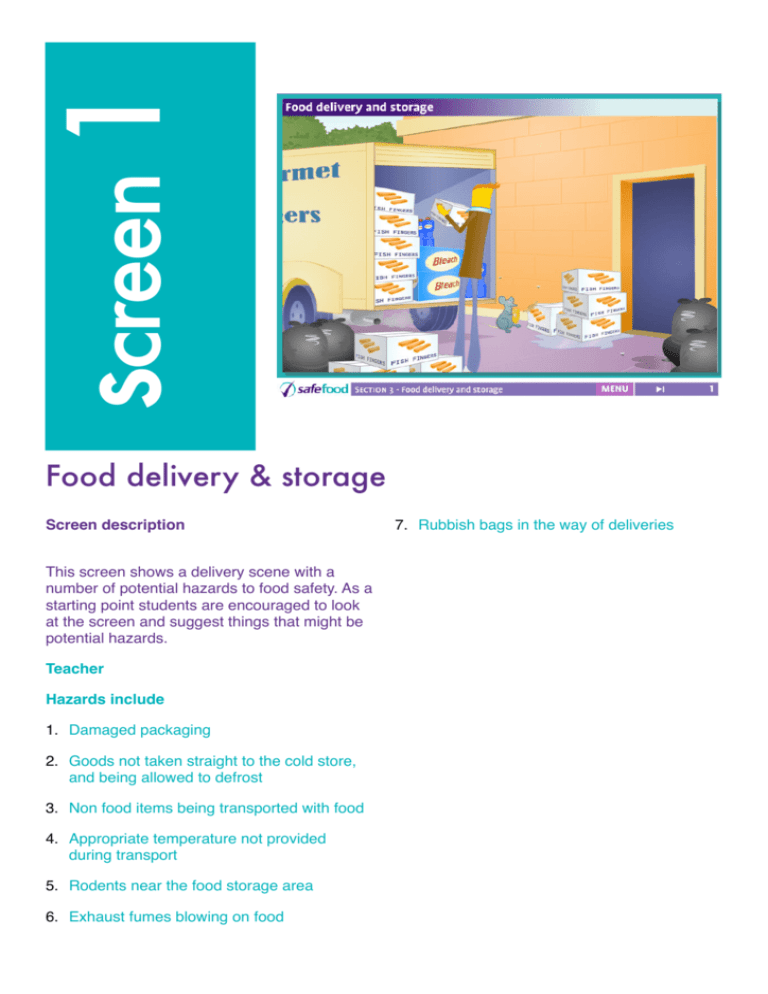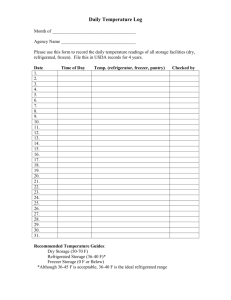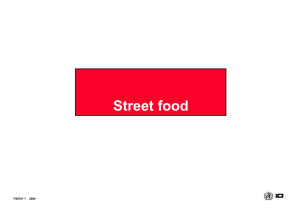Food delivery & storage
advertisement

screen 1 Food delivery & storage Screen description This screen shows a delivery scene with a number of potential hazards to food safety. As a starting point students are encouraged to look at the screen and suggest things that might be potential hazards. Teacher Hazards include 1. Damaged packaging 2. Goods not taken straight to the cold store, and being allowed to defrost 3. Non food items being transported with food 4. Appropriate temperature not provided during transport 5. Rodents near the food storage area 6. Exhaust fumes blowing on food 7. Rubbish bags in the way of deliveries screen 2 Food delivery and storage Screen description This screen lists the objectives of the chapter 1. Identify the correct procedures for receiving and accepting food deliveries 2. Identify the correct procedures for storing food 3. Name the various food storage areas and the potential hazards associated with each area 4. List controls/checkpoints for the hazards identified in each food storage area. Teacher Outline the objectives of Session 3. screen 3 Date Marking Screen Description This screen shows items with ‘best before’ and ‘use by’ dates. Teacher Explain the difference between ‘best before’ and ‘use by’ dates. Date Marking All prepackaged foods come with a date indication on the label. These are either ‘use by’ or ‘best before’ dates. Best before Date Best before dates usually appear on canned, dried and frozen products. It is not an automatic offence to sell products past their use by dates, but their quality and safety might be compromised e.g biscuits can go rancid or soggy. Use by Date The use by date for foods is the critical time limit after which foods are considered not safe. After the use by date the bacterial load may be sufficient to cause food poisoning. Use by dates are found on high risk foods likely to cause food poisoning e.g. ready to eat, moist foods, food high in protein, foods that require chilling and foods with a short shelf life. It is an offence to sell food past its use by date. If food is past its use by date dispose of it immediately. screen 4 Food delivery Screen description This screen summarises a food delivery check list. Teacher Explain points to the students. Food delivery checklist A checklist for inspections of food deliveries should be used. All deliveries of food should meet the following requirements: 1. The delivery vehicle must be suitable for the transport of food, e.g. all vehicles must be weatherproof and clean. Vehicles must be refrigerated if used for transporting perishable foods. Air temperature of delivery vehicles: For chilled foods 0°C to +5°C For frozen food –18°C Where food and non-food items are transported in the same vehicle they must be suitably segregated to prevent cross contamination. 2. The delivery personnel must behave in a hygienic manner and wear suitable protective clothing. 3. The food should be free from obvious contamination and in good condition. 4. There should be no evidence of infestation. 5. The food must be within its ‘best before’ or ‘use by’ date, where appropriate. Prepacked goods must, by law, contain additional information such as any storage conditions including storage temperatures, a list of ingredients, origin of food, etc. Any special instructions must be strictly adhered to. 6. The packaging must be undamaged. Reject immediately any damaged containers, torn packages, dented, rusty, leaking or blown cans. Blown cans may be the result of bacterial contamination. Under-processing may result in the production of gas, due to the action of the surviving micro-organisms, which causes the can to swell. 7. All high-risk foods must be delivered either chilled or frozen. A probe thermometer should be used to ensure that the temperature of chilled food deliveries is less than or equal to +5°C and frozen food is not greater than –18°C. Food which is delivered at the wrong temperature must be rejected. 8. Food can become contaminated with harmful bacteria at any stage, so food hygiene procedures must begin when selecting a supplier. The quality of food served is determined by the quality of the raw materials purchased. *The standards of hygiene in the supplier’s premises should be checked prior to purchasing. * Not always possible for small businesses. screen 5 Transporting foods Screen description Screen shows requirements for a food delivery vehicle. Teacher Explain points to the students Food deliveries should not be left exposed to the elements. All deliveries should be transferred to suitable storage without delay. Raw and cooked foods if transported in the same vehicle should be segregated to avoid cross-contamination. screen 6 Delivery checklist Screen description Screen shows a sample delivery checklist. Teacher The checklist items are initially left blank so the students can suggest some. When they are finished click the ‘reveal’ button to see a sample checklist. 1. The delivery vehicle is suitable for the transport of food e.g. all vehicles must be weatherproof and clean. Vehicles must be refrigerated if used for transporting high risk (perishable) foods. Air temperature of delivery vehicles: - For chilled foods 0°C - 5°C - For frozen food –18°C or below Where food and non-food items are transported in the same vehicle they must be suitably segregated to prevent cross-contamination. 2. The delivery personnel behave in a hygienic manner and must wear suitable protective clothing. 3. That the food is free from obvious contamination and is in good condition. 4. There is no evidence of infestation. 5. The food is within its ‘best before’ or ‘use by’ date, where appropriate. Pre-packed goods must, by law, contain additional information such as any storage conditions including storage temperatures, a list of ingredients, origin of food, etc. Any special instructions must be strictly adhered to. 6. The packaging is undamaged. Reject immediately any damaged containers, torn packages, dented, rusty, leaking or blown cans. Blown cans may be the result of bacterial contamination. Under- processing may result in the production of gas, due to the action of the surviving micro-organisms, which causes the can to swell. 7. All high risk foods shall be delivered either chilled or frozen. A thermocouple can be used to record the delivery temperature of food without damaging the individual packaging. This is done by taking between pack temperature measurements. 8. Keep raw and cooked food separate in both the delivery van and once it has been received to avoid cross-contamination. screen 7 Food storage areas Screen description Screen shows food storage areas. Teacher This screen acts as a heading screen for the next sections. Storage conditions should maintain the fitness, nutritional value, appearance and taste of food. In order to protect the food from contamination, accelerated deterioration and multiplication of food poisoning organisms etc., once food deliveries are received, the food should be quickly moved to one of several storage areas namely: 1. Dry goods storage 2. Fruit and vegetable store 3. Refrigerated storage 4. Freezer storage screen 8 Safe food storage Screen description This screen lists where and how to store foods. readily cleanable and maintained in good condition. Teacher Cleaning materials must be stored in a separate area away from food. Store non-food items separately. Ask: Why is stock rotation important? Answer: Stock rotation is essential to avoid spoilage. Ask the students to give examples of stock rotation. The ‘first in – first out’ (FIFO) principle must be followed at all times. Daily checks must be made on short life products. Outer packaging must be disposed of prior to storage to minimise the risk of potential contamination. Care should be taken to retain any ‘best before’ dates or codes. To prevent cross-contamination from raw foods (especially meat, poultry and shellfish), to cooked or prepared foods it is very important that they are stored separately. Storage containers should be of proper design, screen 9 Dry goods store Screen description This screen shows the hazards and controls associated with the dry goods store. Teacher The controls are not revealed, so the students can suggest some. When they are ready click the reveal button for a definitive list. Explain control points. Also highlight to the students that the dry goods store of a catering establishment is usually a small store room. A comparison should be drawn with the dry goods store of a normal household which is in a press or cupboard. Potential hazards Potential hazards which must be controlled in dry goods storage could include bacterial growth due to cross-contamination and excessive moisture, contamination by pests and insects and chemical contamination from cleaning agents. Controls To control these hazards dry goods stores must be kept cool, dry and clean. The store must be well ventilated and free from dampness. The store must be bright and food must be stored off the floor on shelving which is made of impervious/non absorbent material or coated with an impervious and easy to clean waterproof material. Containers used for storage must be covered. Opened packages of food such as flour or sugar should be decanted into well-sealed containers. Windows should be fitted with insect screens and the store kept free from infestation by rodents and insects. screen 10 Fruit & vegetable store Screen description This screen shows the hazards and controls associated with fruit and vegetable storage. Teacher The controls are not revealed, so the students can suggest some. When they are ready click the ‘reveal’ button for a definitive list. Potential hazards Potential hazards which must be controlled in fruit and vegetable storage include insect infestation and accelerated spoilage caused by heat and moisture. Fresh vegetables pose a special problem due to the large quantities of soil which they or their containers may bring into the premises. Pre-washed vegetables should be stored separately. Controls Vegetable stores must be clean, well ventilated with good lighting and pest-proof. Outer packaging should be removed and all fruit and vegetables should be stored on suitable shelving to allow good air circulation. Fruit and vegetables in storage must be inspected regularly and items that show signs of spoilage must be discarded. Salad items and soft fruits (except bananas) should be stored in the refrigerator. screen 11 Guidance on cleaning chillers Screen Description Screen shows points on cleaning chillers Teacher Explain the points to the students Guidance on cleaning chillers • Remove all food • Keep food under refrigeration while cleaning the chiller • Clean the chiller from top to bottom • Ensure the chiller is at the appropriate temperature before you return the food to the chiller screen 12 Refrigerated storage Screen description This screen shows the hazards and controls associated with refrigerated storage. Teacher The controls are not revealed, so the students can suggest some. When they are ready click the ‘reveal’ button for a definitive list. Ask: Why must hot food be cooled before storing in a refrigerator? Answer: Hot food must not be placed directly into the refrigerator as it will raise the temperature of the refrigerator above acceptable limits and may cause condensation leading to cross-contamination. Potential hazards Potential hazards that must be controlled in refrigerated storage include bacterial growth, cross contamination, and food beyond date marking. Controls Refrigeration slows down bacterial growth and this is why high-risk perishable foods are kept refrigerated. Refrigerators must not be overloaded as this prevents cool air circulating. Double stacking must be avoided. Refrigerated stores should be maintained at 0°C to 5°C. Cooked and ready-to-eat food should not be stored in the same refrigerator as raw foods, unless the cooked and ready-to-eat foods are properly covered and segregated to prevent cross-contamination. Store raw food below cooked/ready-to-eat food. Refrigerated stores must be kept clean and defrosted regularly. The doors of all stores should be kept closed except when they are being filled, emptied or cleaned. A thermometer and indicating gauges should be provided to check the temperatures of refrigerators, freezers, cold rooms and chilled cabinets on a daily basis. These readings should be recorded. Frozen meat, fish and poultry should be defrosted slowly in the refrigerator. Always follow manufacturers’ ‘use by’ dates. screen 13 Freezer storage Screen description This screen shows the hazards and controls associated with freezer storage. not be overloaded and the door must not remain open longer than is absolutely necessary. Teacher Prior to storage all foods should be properly labelled and dated. Raw and cooked foods should ideally be stored in separate freezers and all foods placed in freezers should be properly sealed/wrapped in order to prevent cross-contamination. The controls are not revealed, so the students can suggest some. When they are ready click the ‘reveal’ button for a definitive list. Ask: What should be done in a domestic situation if there is a power failure and the freezer is full? Answer: Keep the door closed. It is vital that foods are in good condition before freezer storage because freezing greatly retards bacterial growth but will not necessarily kill them. All deliveries of frozen food must be placed in a freezer without delay. Freezers must be maintained at or below –18°C. A blast freezer should preferably be used to freeze foods. Storage freezers are designed to store food that is already frozen. Freezers must Frozen food which has been thawed and not subsequently cooked must not be refrozen. Deep freezers should ideally be fitted with a high temperature audio alarm and/or a high temperature indicator light. During a power failure the freezer should not be opened and in catering establishments if the freezer breaks down there should be an agreed procedure to prevent the waste and contamination of food. screen 14 Exercise Screen description This screen gives instructions for a class activity. Teacher Sample questions and answers that could be used in the survey Do you think you know more about food storage in the refrigerator now than you did before you started? Why not test your friends and family to see how much they know. 1. How often should you check the temperature of the refrigerator? Carry out a simple survey to see if they know how to store food in the refrigerator. As a guide ask them 7 questions which could be taken from your summary sheets. If you ask 10 people you could work out the percentage by multiplying the answer by ten, i.e. 4 of the 10 people you asked knew that raw and cooked meat should be stored separately, therefore 4 times 10 equals 40%. Write up your results and summarise your findings in a conclusion. 2. Where should raw meat be stored? 3. Is it OK to put hot food in the refrigerator? 4. Is it OK to store raw and cooked food together in the refrigerator? 5. Is it a good idea to keep the refrigerator as full as possible at all times? 6. Should food be covered or uncovered? 7. Should you keep the door closed if there is a power cut? screen 15 Exercise Screen description This screen is an interactive exercise. Teacher Ask the students to suggest where the various food items should be stored. Drag the items in to those areas. When you are ready click the ‘reveal answer’ button to see the suggested answers.




